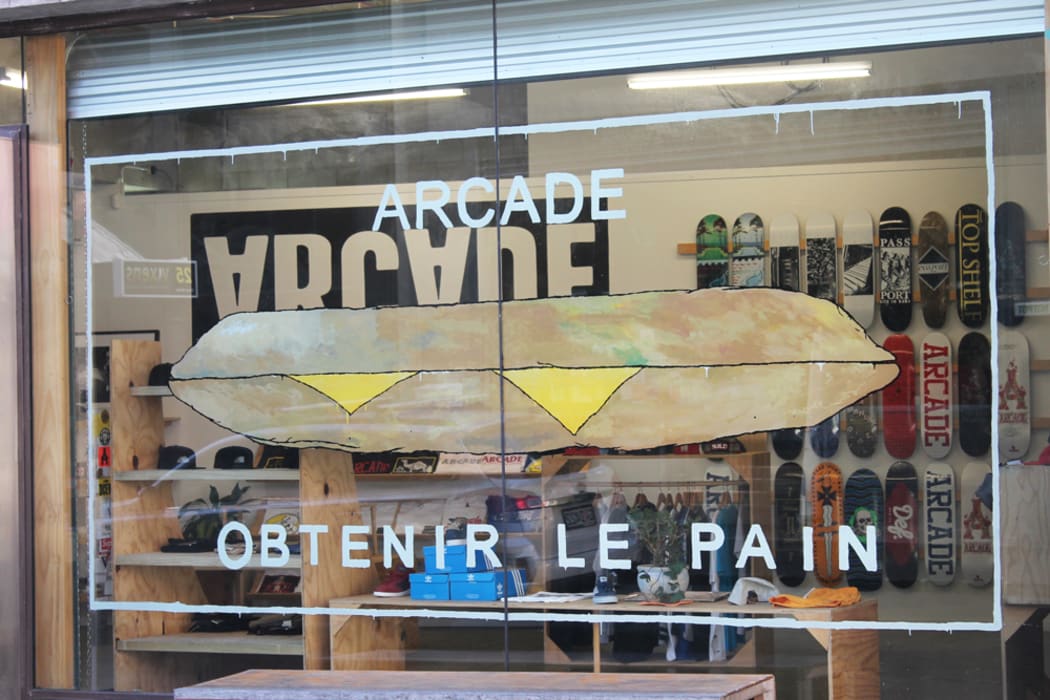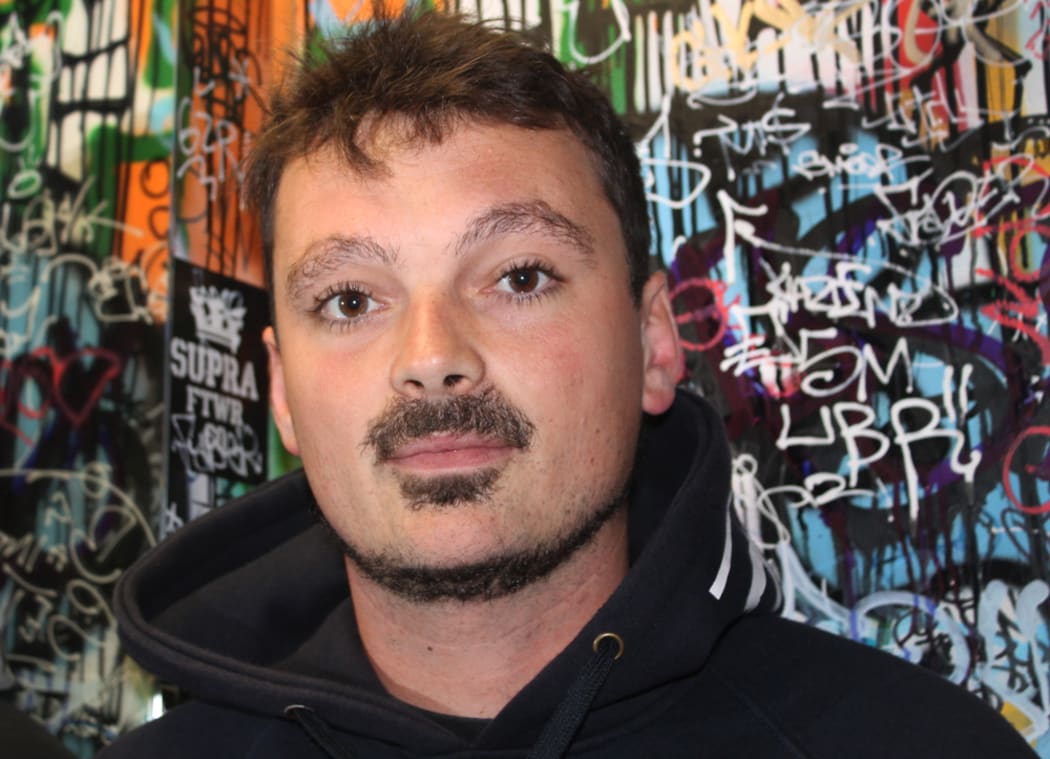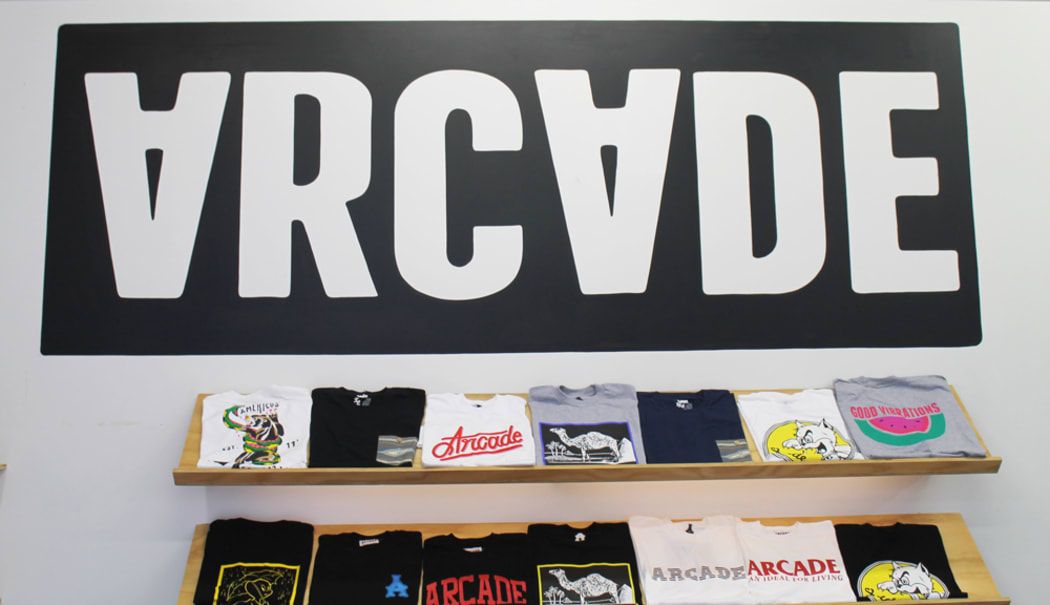In 2013, American musician Kanye West released his first capsule collection with French fashion house APC, the arguable flagship piece of which was a 170 gram-or-thereabouts pile of white Egyptian cotton, sewn into a wearable form and given the definitive title of ‘HIP HOP T-SHIRT’ (capitalisation theirs). Unembellished aside from a tonal ‘APC KANYE’ printed on the inside neckline, this basic but very luxurious item retailed for US$120 and sold out near-immediately.
Earlier in the same year, Kanye’s musical contemporaries Earl Sweatshirt and Tyler the Creator released a song, ‘Whoa’, the hook of which features the couplet “Looking bummy posted on the block/Like I ain’t make a quarter million off of socks.” The socks in question are from Tyler’s Golf Wang clothing line, and though their price point falls significantly below that of Kanye’s collaborative effort, that kind of profit suggests that the Creator is probably comfortably meeting his own self-set KPIs.

Outside Arcade Photo: Lena Hesselgrave / The Wireless
Of course, Tyler and Kanye are by no means the first artists in their field to branch out into the world of menswear. Though never formally chiseled into the Mount Rushmore of Hip Hop Elements, clothing and the way in which it’s worn has been a central tenet of the genre at least since ‘My Adidas’.
I can’t have been the only late-1990s provincial New Zealander with dirt bike-riding sheep-farming true-ass-country friends in shiny Wu Tang pants, but the rise of the social internet has indisputably reinvented the game. Where once rappers’ only real opportunities to articulate a personal style were on album covers and in occasional magazine press, Instagram, Twitter and Tumblr feeds now afford artists the opportunity to ‘stunt’ in the omnipresent.
The flow-on effect to modern consumers is furthered by the extreme ease of acquisition; if my 18-year-old self was alive in contemporary times, I have zero doubts that he’d be spending far too much Jay Z-influenced time on Mr Porter and money on terrible Givenchy all-over-print-everything, instead of Googling Louis Vuitton and fantasising about one day visiting a store that sold Rocawear. I wanted to look into the ways in which performers flex this newly-expanded influence, and to find out how the opening of both hype and distribution channels has altered the streetwear landscape.

Mike Hall, co-founder of Arcade Photo: Lena Hesselgrave / The Wireless
When I visit with Mike Hall, co-founder of Auckland’s Arcade skate store and its corresponding clothing label, he’s sitting outside his shop with rapper Louie Knuxx and two members of @Peace. It’s no great shock, then, when he agrees that music and fashion locally share a reasonably symbiotic relationship.
In their brief history, Arcade have collaborated regularly with Auckland artists like @Peace and Street Chant, as well as presenting a number of shows for local and international artists, both in venues around Auckland and within their compact Cross Street premises. A large number of these connections were carried over from Mike and Arcade co-founder Joel Coombes’ time as party promoters in the city. Mike says their contacts in the local music, art and skate scenes helped the store starting out. “It was ... something we were banking on, really. If we hadn’t had that network to begin with, we probably wouldn’t have even tried.”
He’s honest about the ways in which relationships with international artists can affect a brand’s profile, particularly given the internet’s unprecedented powers of dissemination. Fellow Auckland brand I Love Ugly saw their own global profile spike on the back of A$AP Rocky wearing theirsignature ‘Zespy’ pant, and while the two brands don’t have a great deal in common aside from geography, the team behind Arcade have also benefited from some fortuitous associations.
Auckland-born, United States-based photographer Tom Gould shot New York rapper Action Bronson prominently wearing an Arcade hat in 2011. The resulting image was widely used as a press photo by Bronson and printed on a t-shirt by Arcade, planting the seed for a relationship that most recently saw Bronson wearing Arcade’s gear and swandiving into the Hauraki Gulf for legendary cultural catch-all WorldStarHipHop. Arcade’s status also received a boost when Odd Future-affiliated rapper and producer, Left Brain, was photographed wearing another of their hats, shortly after the group’s controversial trip to Auckland for the 2011 Big Day Out.
Given the inclination for hype-fuelled internet-based Shopping Without Borders that fuels our own antipodean pursuit of trill-garms, it’d be easy to expect co-signs like these to function as a promotional silver bullet, but Mike’s not so sure.

In store at Arcade Photo: Lena Hesselgrave / The Wireless
“You give a hat away, and half the time [the artist] never wears it, or they do and no one cares. We get a lot of requests, but we have to see a value in it ... there’s people that we know that are a big deal who we couldn’t consider giving a t-shirt to because it wouldn’t do anything.”
But despite Mike’s reluctance to place too much stock in hype, Arcade has reached a certain level of prestige, at least locally. On my way out of the store, he shows me a video that a friend found on YouTube. Artfully filmed and tastefully graded, it’s a young New Zealand rapper heavily indebted to the sub-bass thick ‘trap’ style of A$AP Rocky’s oeuvre and the visual style of the same. Notably, his wardrobe throughout very clearly and deliberately alternates between a Hood By Air t-shirt (a brand conspicuously worn by Big Sean on his Hall of Fame album cover, among many other pop cultural appearances) and an Arcade one. Like the oft-maligned but hardly malignant combination of localised slang with Americanised accents, it’s an example of artists working with a set of rules determined by an international culture but still putting on for their place of origin.
Of course, even internationally established brands regularly look to musicians to lend credibility and cachet. In a candid and occasionally intense interview with American radio DJ Sway in late 2013, Kanye West made mention of his long-awaited and quasi-mythical Nike collaboration, the Air Yeezy II “Red Octobers”. The shoe, a strictly limited all-red colourway of his 2012-released style, had suffered continued release-day setbacks since its original announcement in mid-2013, eventually culminating in Kanye throwing powerful shade at Nike’s CEO during one of his American concerts. Predictably, their business relationship quickly dissolved, and Kanye stated during the interview that he had no idea when the shoes would be released, or even whether they’d appear at all:
I can’t imagine ever lacing up a pair of solid red basketball boots without the deep and gnawing self-awareness that they’d definitely make me look like an ill-proportioned fancy toddler.
“You know what Nike told me, when I asked them? ‘We ain’t sure.’ You know what they told ... my boy that run the store though? ‘If y’all want that Red October you gotta take these 10 other shoes.’”
But appear they did. On a Sunday in February, early in the American afternoon, without any recent publicity, a communiqué from Nike’s official Twitter account announced that the shoes were now available on their webstore for the not-insignificant sum of US$245. Despite Nike’s apparent efforts to minimise the impact of the release, a subsequent tweet 11 minutes later announced the exhaustion of their supply. Since then the Red Octobers have quickly become known for their auction site-based hyperinflation, like a sort of bitcoin equivalent for sneaker scalping eBay scoundrels.
Though it’s always difficult to separate the art of apparel from its ever-present commerce, especially in the case of an item so notable for its resale value, it’s not hard to see why Kanye’s efforts appeal. For the most part, he’s working within a framework best defined as “Luxe Basics” – or possibly less charitably as “Luxe for Basics” – making and endorsing and even just wearing nice clothes that cost a lot of money but don’t present as particularly visually radical.
Some are more universally wearable than others. I can’t imagine ever lacing up a pair of solid red basketball boots without the deep and gnawing self-awareness that they’d definitely make me look like an ill-proportioned fancy toddler, but I’d be lying if I said I didn’t consider buying a Stutterheim raincoat after an Auckland boutique advertised it with this photo (thankfully I never pulled that particular trigger, because while wearing a rapper-approved Scandinavia-proof raincoat is undoubtedly a strong sartorial move, in subtropical Auckland it’s also an enduring commitment to spending the rainy season feeling like a human swamp).
The clothes offered by Tyler hold a similar appeal, though skewing significantly younger and wilder. Designs and palettes occupying the relatively obscure intersection of the Supreme-led skate and streetwear aesthetic, also the Spongebob Squarepants hypercolour aesthetic, earlier mined by Pharrell Williams’ Billionaire Boys’ Club and Ice Cream lines. They’re pieces that might seem crude or garish to those outside these labels’ remit, but they know their market and serve it well.
Despite their aesthetic disparity, all of the brands I’ve mentioned could stake a reasonable claim for successfully having realised both their creative and fiscal ambitions. As with all endeavors of this nature, however, that’s not always the case:
The pet project of A$AP K! and A$AP Bari, from the A$AP Mob, called VLONE is an example of such a company artistically missing the mark. Pronounced VEE-LONE (unlike when they spell A$AP as ‘V$VP’, throwing a spanner in the works for those who believe in crew-wide linguistic continuity), the label produces hot-garbage-tier streetwear; creatively as groundbreaking as the nu-rave slogan tees that everyone’s vague acquaintance started making in 2009 and with the exact same level of execution.
Regardless of any quality-based judgments, though, VLONE is marketable. The collection shares a hook and a basic philosophical grounding with work like APC KANYE, in that it’s ostensibly clothing that reflects the artists responsible for making and promoting it, and so if you consume it you’ll be, in some minor way, closer to kinfolk with these creative arts deities. It’s the same idea that sells replica rugby jerseys and pro-model skate shoes, but there’s an implication of a higher level of consumption involved in this context - rappers like Kanye and A$AP Rocky have made their wardrobes a focal point of their music; Rocky going so far as to release a reasonably high-charting single called ‘Fashion Killa’, which functions less as a song than as a braggy and overlong laundry list – and so their co-sign strongly implies that the endorsed brands have an inherent higher value.
Even from a New Zealand, the impact that these international artists have had on streetwear is noticeable. Brands like the Been Trill and Pyrex projects helmed by Kanye West’s creative director Virgil Abloh, and Hood by Air and VLONE, are stocked scarcely if at all in physical outlets, but can be easily purchased from international webstores and often found locally via Trade Me and Facebook marketplace pages.
Late in Kanye West's interview with Sway, the radio DJ attempts to broach the subject of their own respective investments in fashion projects. As the host tells West that he’s personally invested and lost considerable sums of money in various ventures, Kanye interrupts him with a sharp “It ain’t Ralph though”.
What Kanye's saying is that Sway can’t relate, because he’s operating on a level below that of the Ralph Lauren symbolised old guard that West aspires to. But though Ralph Lauren is central to the canon in terms of male-orientated, rap-influenced streetwear, it’s also a pillar of conservatism.
Kanye’s work in the apparel industry may not have yet matched the abrasion of his recent music, but he has, like many of the other artists in this story, a strong belief in the value of iconoclasm.
Setting aside opinions about their various qualities of concept or execution, and regardless of their methods or means, it’s clear that they’re working towards a similar goal: not to succeed through emulation of their elders, but through subversion. To create brands and household names known not as analogues to the establishment, but as alternatives.
It ain’t Ralph, but that’s the point though.
This content is brought to you with funding assistance from New Zealand On Air.

